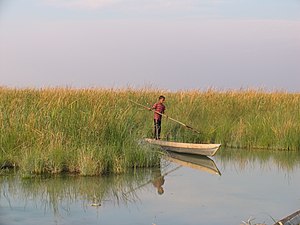Shadegan Ponds

| Designations | |
|---|---|
| Official name | Shadegan Marshes & mudflats of Khor-al Amaya & Khor Musa |
| Designated | 23 June 1975 |
| Reference no. | 41[1] |
The Shadegan International Wetland is a series of Ramsar wetlands, which is a designation given to wetlands of international importance under the Ramsar Convention. It covering about 400,000 hectares in Khuzestan Province, Iran. The ponds and surrounding marshes are fed by the Karun river and are connected to the Persian Gulf.[2] The soil surrounding the wetlands is saturated with groundwater and the wetlands themselves are calm and a rich habitat for wildlife.
Animal life in the Shadegan ponds include two species of amphibians, five species of reptiles and 154 species of birds, among them pelican and flamingo. The area is also known for its birds of prey and is very important to migratory birds. There are also 40 species of mammals present, among them the Iranian wolf, river otter, jungle cat and wild boar.

The area suffers from pollution from leaking oil pipes, industrial waste and agricultural fertilisers. However, the economic dependence and income generated from this wetland is immense, most of values are either ignored or underestimated in policy related decisions. Given the diversity of social, economic, and environmental benefits that derive from the Shadegan International Wetland, strong opinion exists that people, especially those living around the wetland, are dependent on wetland and gain long-term benefit from this ecosystem. Therefore, one major role of wetland management which is to estimate the value of various aspects of a wetland should not ignored.[4][5]
Environmental conditions at the wetlands vary throughout the year. In the fall and winter, rains in the Zagros Mountains send water flooding through an intricate series of shallow lagoons and marshes. Many of these areas dry out during the summer months.[6]
References[edit]
- ^ "Shadegan Marshes & mudflats of Khor-al Amaya & Khor Musa". Ramsar Sites Information Service. Retrieved 25 April 2018.
- ^ Pandam Consulting Engineer (2002) The natural environment of Shadegan Wetland ecosystem. Report 1 of the EC-IIP environmental management project for Shadegan Wetland.
- ^ "Shadegan Pond".
- ^ Kaffashi, S., Shamsudin, M. N., Radam, A., Yacob, M. R., Rahim, K. A., & Yazid, M. (2012). Economic valuation and conservation: Do people vote for better preservation of Shadegan International Wetland?. Biological Conservation, 150(1), 150-158.
- ^ Shamsudin, M. N., Radam, A., Rahim, K. A., Yacob, M. R., Muda, A., & Yazid, M. (2011). Economic valuation of Shadegan International Wetland, Iran: notes for conservation. Regional Environmental Change, 11(4), 925-934.
- ^ "Shadegan Pond". earthobservatory.nasa.gov. 2017-02-12. Retrieved 2023-05-26.
